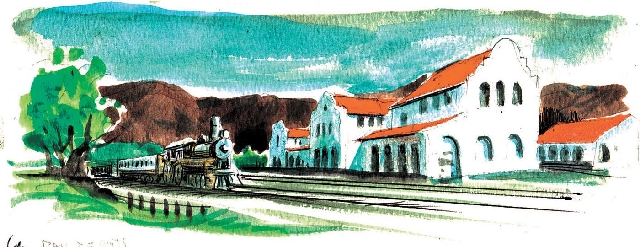Follow tracks for clues to Nevada’s railroad history

Thousands of miles of track once connected Nevada towns with the transcontinental railroads. From territorial days to modern times, at least 70 railroads operated in the state, both standard and narrow gauge. Built to move ore from mines to mills, the lines also carried freight and passengers.
Sometimes they existed for very specific purposes. The list of old railways includes the Austin City Railway, dubbed the “Mule’s Relief” and built to conquer the steep climb into the boomtown. Just the engine house still stands along U.S. Highway 50.
Today, Nevada’s network of rails has all but disappeared. Trains on just two railroads now speed along some 1,200 miles of track. The Burlington Northern and Santa Fe crosses the northern part of the state, and Union Pacific trains run through Southern Nevada. Passenger service has dwindled to Amtrak trains on just the northern route.
Many factors led to the demise of Nevada’s railways. For the smaller lines, survival depended on sustained ore production. Some lasted for decades, but most operated only during brief mining booms.
America’s love affair with the automobile spawned the network of roads and highways that connects communities, often along routes pioneered by railroads. Trucks began replacing rail cars. Many abandoned tracks lay rusting until World War II, when their steel was used for the war effort. Railroad ties also were recycled. Erosion wore away at the old road beds. Only traces of them remain throughout Nevada.
Many railroad towns declined when diesel locomotives replaced steam engines. When trains stopped running, some towns just disappeared. Throughout Nevada, some buildings erected by the railroads still exist, ghosts of a lively and colorful era. Some await uncertain fates. Others have been moved from their original sites. A few have been restored and repurposed. All of them hold interesting stories that make them worthy stops on road trips through Nevada.
In the Las Vegas area, head to the Clark County Heritage Museum on Boulder Highway to see examples of railroad houses that stood along downtown streets and the original Boulder City Depot built for the spur line that carried construction materials to the site of Hoover Dam during the 1930s. Part of the original track now carries excursions on the Nevada Southern Railway from Boulder City to Railroad Pass, a state railroad museum.
Follow U.S. Highway 93 north to Caliente, where the town’s handsome two-story mission-style depot, built by the Union Pacific in 1923, now houses businesses, a community center and city offices.
Continue north to Ely to tour the Nevada Northern Railway complex, donated for a museum by Kennecott Copper when it ceased mining operations in the area. The line served the region for 60 years. Now excursion trains with restored locomotives and rolling stock run on two original routes, and the 1907 depot and offices are part of the state museum system.
More railroad history can be found along U.S. Highway 95 north of Las Vegas. Rhyolite, a ghost town four miles from Beatty, features ruins and a few intact buildings, including the 1907 depot that served three railroads. Look for repurposed railroad structures in Goldfield and Tonopah, and visit Tonopah’s Mining Park.
Railroad houses stand along the highway in Mina, where the community center is housed in the old Southern Pacific Depot that stood nearby in Luning.
In Hawthorne, the Carson and Colorado Railroad Depot is now a clubhouse.
In Fallon, the wooden, two-story SP Depot is part of a casino.
Fernley relocated and restored its ornate 1914 depot from the Fernley and Lassen Railway.
Historic railroad buildings survive in Reno, some awaiting rehabilitation.
In Sparks, the two-story depot from Wadsworth serves as a railway office.
Gold Hill’s V&T Depot houses a local museum.
The Nevada State Railroad Museum in Carson City and a restored portion of the historic V&T Railroad between Virginia City and Carson City are popular tourist attractions.
Margo Bartlett Pesek’s column appears on Sundays.












